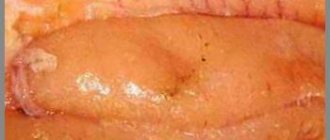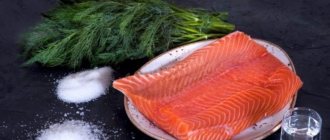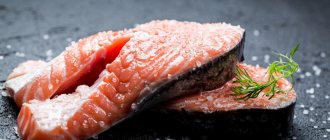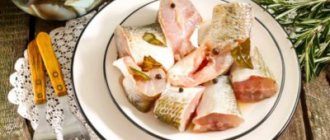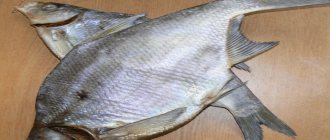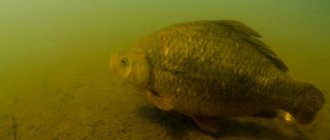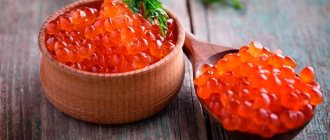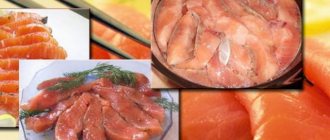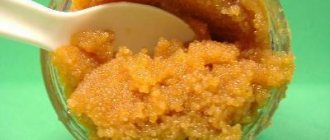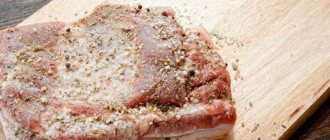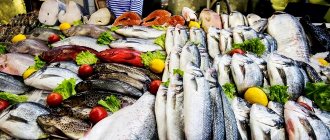At home, you can prepare delicious balyk not only from sea fish. River asp is an ideal option because it is quite fatty, and the finished dish will have a pleasant aroma and excellent taste. By following simple recipes you can create a real masterpiece from a minimal set of ingredients.
Extraordinary taste and pleasant aroma
How to cook balyk from asp
To prepare asp balyk at home you will need a little time and a minimum of spices. Following the technology will allow you to create an exquisite culinary masterpiece that will become the highlight of the table. The taste of asp meat is somewhat reminiscent of pink salmon and chum salmon, and the cost of such a product will be much cheaper.
Choosing fish for balyk
Before you make balyk from asp at home, you need to choose the right carcass. The fish must be fresh. Often, fishermen prefer to prepare balyk from asp right at the fishing spot. Meat is the most delicious and fatty in summer and autumn.
If the carcass weighs more than 1 kg, then it is already suitable for cooking. And if the person is over 3 kg, then it is imperative to prepare balyk from such asp.
Proper cleaning and cutting of the carcass
A sharp knife is the main tool with which it is easy to cut an asp. In this case, the balyk will turn out to be beautifully shaped. Before cutting, the fish is washed and the scales are removed.
The further algorithm is as follows:
- An incision is made from head to tail on the dorsum.
- The ridge is neatly stretched.
- The abdomen should remain intact.
- The opened fillet is cleaned, the bones are carefully pulled out with tweezers.
- The gills are cut out with a knife.
- The carcass is thoroughly washed under running water and dried.
Fish for balyk must be perfectly clean. It should not contain bones or blood. So, you can enjoy exquisite taste without worrying about anything.
Types of pickling
Different recipes for asp balyk at home involve different methods of salting the fish. Some of them are best used when cooking at home, while others are relevant when cooking outdoors. In any case, it is better to use coarse salt, as it dehydrates the fillets better.
Dry salting
The traditional option is the dry salting method. To do this, the carcass is thoroughly coated with salt on all sides. It is necessary to ensure uniform application. Then the balyk asp is sent to the refrigerator overnight, and during the day it is cleaned of excess salt and soaked in water.

Dry salting
The larger the fish, the less it needs to be soaked. So, for a 1-kilogram individual it takes about 3 hours, and for a 3-kilogram one – 1 hour.
Concentrated brine
This method is chosen if balyk is prepared outside the home. It allows you to preserve fish for a long time.
Salt is added to the water in the proportion of 1 liter per 400 g. This portion is enough for a small amount of fish. If there is a lot of asp, then you need to take more water and salt. The liquid is brought to a boil. The fillet is dipped into the cooled brine. 8 hours is enough for complete salting.
Lightly salted brine
The recipe for asp balyk, prepared at home using lightly salted brine, is suitable for those who do not like salted fish. Prepare the marinade from 1 liter of water and 40 g. salt. As in the previous case, the brine is brought to a boil and cooled. The asp is placed in liquid for a day. After this, you can proceed to the next stage.
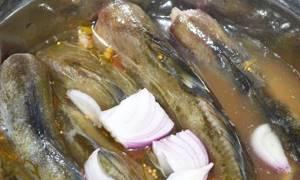
Fish in brine
Regardless of the chosen pickling option, you can use additional spices to enhance the taste. They often use ready-made seasoning for fish, but you can choose a set of ingredients yourself.
They approach the asp:
- ginger;
- black pepper;
- carnation;
- coriander;
- dill and fennel seeds.
By adjusting the ingredients, you can make your own recipe and glorify your name among relatives and friends.
Drying asp
The original technology involves long-term drying for 3-4 months under certain conditions. But home cooking can be speeded up: place the asp balyk in the open air or use the oven. It is better to carry out the procedure in spring. Weather conditions make it possible to eliminate the negative influence of the scorching rays of the sun, which leads to the growth of bacteria and spoilage of the product. The duration of cooking in the sun is about 3 days. Using the oven, you can make balyk at home within a day.
When placing fish outdoors, you should protect it from insects. Gauze soaked in vinegar will cope with this task. When drying, it should be periodically re-moistened with vinegar to repel flies, ticks and other pests.
How to properly dry asp, recipe for “wet salting”
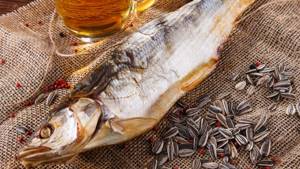
Dried asp tastes no worse. The recipe for its preparation is not much different in composition from balyk.
Ingredients. Here is the "wet" method:
- Coarse table salt at the rate of 0.8 kg per 2.5 liters of water.
- 10 kg of fish (it is advisable to select carcasses of the same size and weight).
- 2 – 2.5 m of gauze or other light fabric.
- Spices:
- 3 bay leaves;
- 6 – 8 black peppercorns;
- ¼ spoon of dry dill;
- ¼ teaspoon fennel seeds;
- 1 - 2 medium cloves of garlic.
Preparation. The salting procedure is simple, but relatively long-term:
- Prepare brine or brine for salting fish: boil water, simultaneously dissolving salt in it. Just before boiling, pour the prepared spices into the pan to give the desired taste.
- After boiling, set aside and let cool.
- We cut the fish in the usual way: we clean the insides and gills, but we add another touch: we cut along the entire length of the back from head to tail.
- Place the cleaned and washed fish in a bowl and add a little salt.
- Fill with ready-made brine (temperature of the finished brine is 30 - 40 degrees). It should cover all the carcasses by 2 - 3 mm.
- And then we remove the container for 48 hours in a cool, dark place.
- After this time, hang the salted fish in a row on a nylon thread (for asps, it is better to thread the thread through the eyes). We protect with gauze cloth from the attacks of flies and other insects.
The drying place should be shady, dry and well ventilated. After a couple of weeks, you can begin to remove the first specimens, which are smaller, and monitor the degree of readiness of the rest of the fish.
The best recipes for making balyk from asp
There are many recipes for making asp balyk at home. Each of them allows you to make an original dish with exquisite taste. Individual ingredients give the product an unsurpassed aroma, and the subtleties of salting and drying make it possible to obtain a juicy and tender balyk.
Asp in Astrakhan
Astrakhan is a region famous for fishing. Rich catches have led to the fact that residents began to create original recipes with which everyone can prepare delicious dishes without much effort. For 3 kg of asp you will need 300 grams. salt.
The step-by-step instructions look like this:
- The fish is cleaned and cut.
- Soak the carcass in ice water and dry.
- Make cuts where the meat is thick.
- Rub the fish with salt on all sides.
- Place the product under pressure and place in the refrigerator for 12-15 hours.
- Soak the salted fish in water for an hour.
- Hang out the balyk for drying.
This asp will delight you with its taste, and it will also have an attractive golden crust if you hang it in the sun for a while.
Sugar balyk
This recipe is similar to the previous one, but you will need to include sugar in the ingredients. It will help make the dish taste exquisite, and it also helps the salt penetrate deeper into the fibers. For a fish weighing 3 kg you will need:
- 300 gr. salt;
- 150 gr. Sahara.
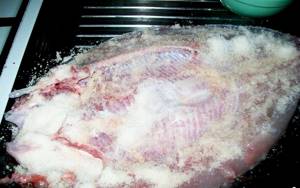
Balyk is prepared according to the following algorithm:
- The fish is cleaned, washed and cut into pieces if the carcass is too large.
- The fillet is rubbed on all sides with salt and sugar.
- The meat is placed in a container and placed under pressure.
- The container goes into the refrigerator for 4-6 days.
- The fillet is washed under running water for 1 hour or soaked in cold water for 4-5 hours.
- The asp is wrapped in gauze and placed in a ventilated room or outdoors, but not in the open sun.
The duration of drying depends on personal preference. If the balyk should be dry, it will take about a week, but for a juicy and soft product, 4 days will be enough.
In this case, you should periodically check the meat for readiness, since the speed of drying depends on external conditions.
Wet pickling recipe
This recipe is often used when traveling. It is also used when subsequent smoking is planned. A strong saline solution - brine - is prepared using exclusively salt, sugar and water. But in some cases, spices are added to taste to make the fish with a piquant aroma. To check the readiness of the brine, dip a raw egg into it. It should float to the surface.
The asp is placed in brine and placed under pressure. You can pre-string carcasses or pieces onto twine. This will make further drying and smoking at home easier. To salt balyk from asp, it will take from 3 to 5 days.
After salting, the fish is washed for about 30-60 minutes and hung for airing.
Pickled asp – finger-licking recipe
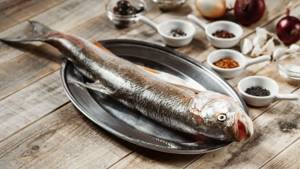
Pickled asp also tastes good. Let's take a recipe with vinegar for variety.
Ingredients. What products will we need?
- Fish – 2 pieces, approximately 2 kg each.
- Vinegar 9% - 250 grams.
- Water – 100 grams.
- Ground black pepper – 50 grams.
- Seasoning “Mixed peppers” with peas – ¼ teaspoon.
- Red pepper, hot – ½ teaspoon.
- Dried dill – 1 teaspoon.
- Dried parsley – 1 teaspoon.
- Soy sauce – 1 teaspoon.
- Sunflower oil (preferably refined) – 1 tablespoon.
- Onion variety “Greatful Red F 1” – 1 medium head.
- Onion variety “Strigunovsky local” - 1 medium head.
- A pinch of finely ground salt.
Let's cook. The cooking process is simple:
- Set aside 1 level teaspoon of black pepper.
- Mix vinegar and water in a glass jar of sufficient capacity.
- Add parsley, dill, soy sauce, red pepper, remaining ground black pepper, mixed pepper seasoning, and salt. Mix everything well and move it aside to let it brew.
- We take the fish, wash it, clean it of scales and entrails. Separate the head and fins.
- Cut into slices approximately 1 cm thick across the fish carcass. We rinse again to remove any remaining scales and blood.
- Take a cup of such a diameter that the resulting slices lie in two rows. Gently shake the contents of the jar and pour about a third of it into a cup.
- Place the pieces in a circle in two rows.
- Shake again and pour the rest onto the fish rows.
- Sprinkle with reserved pepper.
- Peel and cut the entire onion into thin – up to 1 mm – half rings. We place the red and white varieties mixed on top of the entire resulting composition.
- Press down a little with your hands to wet it in vinegar.
- Let it brew for 10 – 15 minutes.
How to properly store balyk
The product should be stored exclusively in the refrigerator. The fish is wrapped in thick paper, preferably parchment paper, as it does not absorb fat, and sent to the refrigerator. To add flavor, you can put sprigs of dill or garlic in the package. This product can be stored for a long time if the conditions are met.
Balyk from asp is a very exquisite dish that will become a real decoration of the table.
It goes perfectly with any side dish, and will also become the most delicious snack to accompany beer. Cooking at home will make the product as tasty and safe as possible, while saving money.
Salting the carcass
Every fisherman and housewife has their own salting secrets. But how to make balyk from asp without knowing them? However, it's quite simple. It is enough to know 2 methods of salting, they are the main ones.
- Dry salting method. You need to take coarse rock salt and generously rub the prepared asp on all sides. You need to rub the carcass so that the salt penetrates into each fold and is fixed in it. After this, the fish must be placed under oppression for 12 hours. Then they can be taken out and cleaned of excess salt by rinsing and soaking in clean water.
- Salt in brine (brine). This method requires a saucepan. You need to pour the required amount of water with salt into it and boil it. You can use peeled potatoes to check the concentration. If it floats up, then there is enough salt. After the brine has cooled, the prepared carcasses are immersed in it and left in the refrigerator for 12 - 14 hours. Afterwards, the asps are taken out and then soaked in plain water.
By the way, you can add spices to the brine, so the taste will acquire new notes and become more piquant.
After completing all the steps of salting and soaking, they proceed to the drying process.

The smaller the fish, the longer it should be soaked. So carcasses up to 1 kg are soaked for about 3 hours, and large ones - no more than 60 minutes
How to fry properly
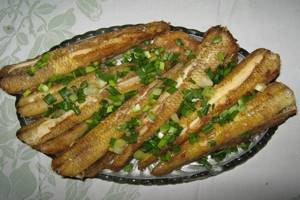
The easiest way to cook asp is to fry it in a frying pan with oil. It turns out very tasty and also quick. The recipe requires a minimum of ingredients, but you can add others.
- medium asp carcass;
- tsp salt;
- ½ lemon;
- spices;
- vegetable oil for frying.
Remove scales from the fish, gut the insides, and rinse with water. Remove the gills to prevent the meat from becoming bitter, or cut off the head altogether. Make shallow cuts crosswise on the sides with a knife, they are needed so that the meat is fried more evenly.
Blot the carcass with dry napkins to remove excess moisture, rub the outside and inside with salt and spices; cumin, rosemary, coriander, thyme, and ground black pepper work well. Squeeze lemon juice to neutralize fishy odor while cooking.
Add a little oil to the frying pan and heat it over medium heat. Once the surface is hot, carefully transfer the fish into the frying pan and fry on both sides until golden brown. The total cooking time takes 10-12 minutes. Then, as soon as the crust forms, cover the pan with a lid, turn the heat to low and continue cooking for another 5 minutes.
Blot the finished asp from the oil with napkins and serve hot with rice or a salad of fresh vegetables. Bon appetit!
Salting caviar
Salting caviar is as easy as preparing balyk. According to the recipe for a lightly salted dish, you will first need to remove the film; for this you can use a large sieve through which you can simply wipe it.
Then take 20 grams of salt, 10 grams of sugar per 100 grams of caviar and add it to sleep. If desired, you can use dry herbs or spices, but this will be unnecessary. Mix everything well, put it in a glass jar, close the lid and put it in the refrigerator for a day.
You can spread the product on bread with butter and enjoy its amazing taste.

To learn how to pickle asp, watch the video below.
Spicy salted asp or “Herring from asp”
After the summer and autumn seasons, at the beginning of winter, the asp, having gained fat for wintering, becomes a very tasty fish. I noticed that many of our amateur fishermen really like to catch asp in the autumn and spring. But not everyone takes it home after fishing, because they don’t know what to cook from it or are too lazy to clean it, citing the fact that they don’t like to eat asp. But in vain...
You've probably heard, and many may have even tried or made your own “herring from asp”. And some people generally do not perceive asp in gastronomic terms as a tasty fish, considering it very bony. For me, asp is one of my favorite types of fish in culinary delights. Since it is a predator, it does not have such a pronounced fishy smell and I like this most of all. From asp I prepare several types of dishes: Heh and cutlets from the back of asp fillet, fried asp of various types, panchani from asp, marinated asp, chebureki from asp, as well as herring.
I want to share with you my recipe for making “asp herring”. The recipe is not at all complicated, even the laziest or least experienced person can easily make this dish.
Based on 1 liter of brine:
bay leaf - 3 pcs.
coriander - 0.5 teaspoon
1. Place a pan on gas with the volume of water that you will need for the fish. Add all the spices at once and bring to a boil. As soon as it boils, turn down the gas a little and let the brine simmer for another 5-7 minutes. Leave the brine until it cools completely.
2. Asp fish, preferably specimens up to 1.5 kg.
Clean the fish from scales, gut it from the inside and separate the head, cut off the fins and tail, rinse with cold running water. You will get a beautiful, clean asp carcass. Blot each carcass from excess moisture with a napkin.
3. Place the fish in an enamel or plastic bowl and pour chilled brine over it. Place a pressure on top so that the brine completely covers the fish. Place in the refrigerator or cool place for 4-5 days.
4. When the fish is salted, take it out of the brine and separate the fillets and remove the skin (if there are fans of herring with bones and skin, then you don’t have to do this). Cut the fish into pieces 4 cm wide, onion into half rings or rings and place in layers (layer of fish + layer of onion + pour oil, layer of fish + layer of onion + pour oil and so on, filling the container to the top) in a glass jar or plastic food container , between layers, generously water with vegetable oil, pepper - your choice. Close the lid tightly and put it in the refrigerator for 2-3 days. During this time, the fish will be well soaked in oil and onion juice, which will give it tenderness and melt in your mouth.
How to pickle deliciously

Salted asp is not only a tasty dish, but also very healthy. The meat retains all the necessary microelements, and it dissolves in the mouth. It takes no more than 10 minutes to prepare.
- asp weighing up to 2 kg;
- 2 tbsp. table salt;
- tbsp granulated sugar;
- spices, dry herbs as desired;
- bay leaf – 3-4 pcs.;
- black pepper, peas – 3-4 pcs.
It is better to salt the fish using the “wet” method, then the meat is evenly salted. Take half a glass of boiled water, dissolve salt and sugar in it and add the rest of the ingredients.
Clean the fish from scales, cut off the head and remove the entrails. Rinse the carcass from blood clots and wipe dry with a towel. Transfer the asp to a large deep saucepan and fill with freshly prepared brine. If you want, you can salt it in pieces; to do this, cut the fish into large slices and remove the bones. The time spent on salting takes 8-12 hours.
When the time is up, drain the brine, rinse the fish under water, and place in a colander to drain off any remaining moisture. Cut into portions and place them on a plate. For beauty, drizzle with olive oil and garnish with sliced lemon slices and fresh herbs.
Now you can begin the process of preparing balyk
First, we place the asp belly down on a flat surface of the kitchen workbench.
Then you need to make an incision, but not on the abdomen, but on the back along the ridge. You need to place the knife against the back of the asp near the head, with the blade towards the caudal fin. Make a puncture by hitting the handle of the knife. You need to pierce the carcass slightly to the side of the spine through the back into the abdominal cavity, but you must be careful that the knife does not touch the gall bladder or pierce the abdomen.
After a careful puncture is made from the back to the belly, the carcass should be cut along the spine, without touching the insides, and gutted. This must be done very carefully. Once you touch and pierce the gall bladder, the fish will taste bitter. In fact, we can say that the fish in this case will be spoiled, even if the insides are washed.
